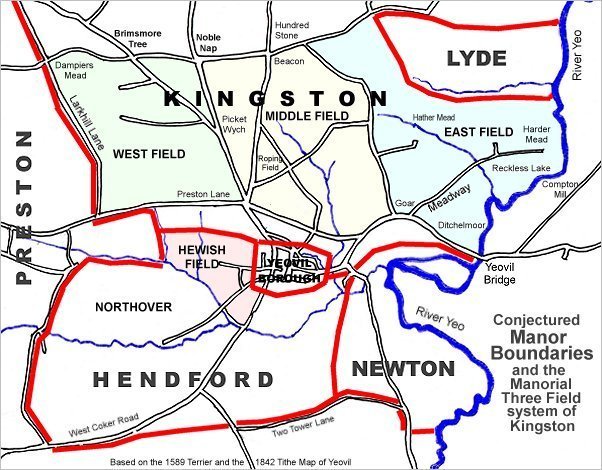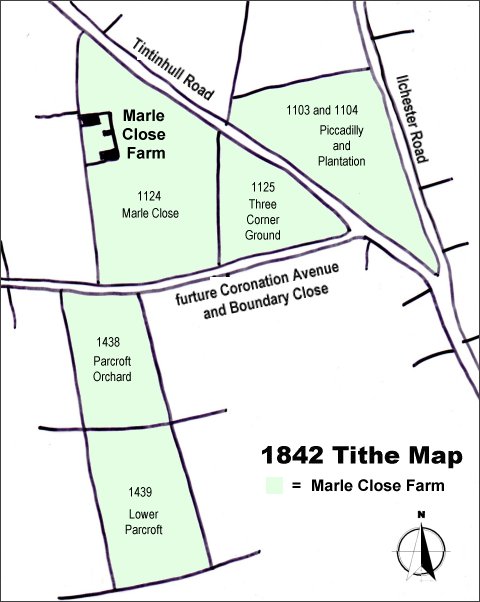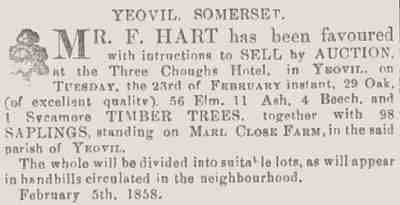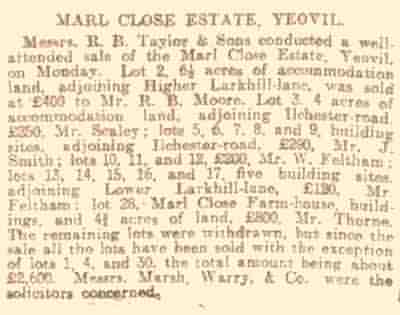Marl Close Farm
Marl Close Farm
A small farm in the former great West Field of Kingston Manor
Marl was originally an old term loosely applied to a variety of materials, most of which occur as loose, earthy deposits consisting chiefly of a mixture of clay and calcium carbonate. It has been used as a soil conditioner and acid soil neutralising agent and was spread on sandy soil by the Celts before the Roman occupation. Its value was realised, and its use revived, by the 'improvers' of the seventeenth and eighteenth centuries.
On the other hand, Marl was also an ancient term used to describe human waste and remote areas of sunken ground were used as a dumping ground and designated as 'marl pits'.
Originally part of the great medieval West Field of Kingston Manor, Marl Close Farm was a small farm around the junction of Ilchester Road, Marsh Lane and a field access track called Lower Larkhill Lane (which would become today's Stiby Road). Marl Close farmhouse was set within Marle Close (Parcel 1424), on its western boundary.
In his will dated 1725, Edward Boucher (1) bequeathed "... Closes of pasture which I formerly purchased of John Game called Marle Close and Three Corner Close..." to his nephew Edward Boucher (2).
The 1846 Tithe Apportionment noted that Marl Close Farm, also spelt Marl Close, was owned by John Glyde (who also owned Wraxhall Farm) and the tenant was William Harrison. In his will of 1845, John Glyde wrote "... And also my Freehold Estate called Marlclose Farm situate in the Parish of Yeovil aforesaid together with the farm house and outbuildings and all lands and hereditaments thereto belonging now in the occupation of William Harrison as tenant thereof and containing by Statute admeasurement Forty seven acres one rood and nine perches ...".
By 1858, the farm was let to a Mr Chaffey. The Chaffey family were still tenants of the farm in 1914 and the farm was offered for sale in 1921, although the reserve was not met. The let of the farm was assumed by J W Marsh Jnr, who quit the farm in March 1929. At this times its stock was sold, comprising 20 dairy cows, 2 bulls and 2 horses.
|
From the
diary of
Louisa
Harris ....
|
Today the site of the former Marl Close Farm is chiefly occupied by the houses and gardens of Thatcham Park, the eastern end of Stiby Road and the northern end of Westfield Grove.
For details on historic land measurement (ie acres, roods and perches) click here.
maps

This map, based on the descriptions in the 1589 Terrier and the 1846 Tithe Map of Yeovil shows the approximate boundaries of the Manors of Kingston and Hendford as well as the manorial three-field system used in Kingston.

A conjectural map of the great West Field of Kingston Manor showing ancient sub-fields, most likely common fields, within the overall bounds of West Field.

A map showing the primary fields of Marl Close Farm.
Land parcels of Marl Close Farm
In 1846, all these parcels were owned by John Glyde and let to William Harrison.
- Parcel
1403 -
Piccadilly
(pasture, 8s
0r 30p)
-
Parcel 1404 - Plantation (included with Piccadilly)
-
Parcel 1423 - House & Garden
-
Parcel 1424 - Marle Close
-
Parcel 1425 - Three Cornered Ground
-
Parcel 1438 - Parcroft Orchard
-
Parcel 1439 - Lower Parcroft
Gallery

A notice of the sale of trees of Marl Close Farm from the 9 February 1858 edition of the Western Flying Post.

Marl Close Farm was sold off, chiefly for housing plots, as reported in the Western Gazette's edition of 22 March 1929.